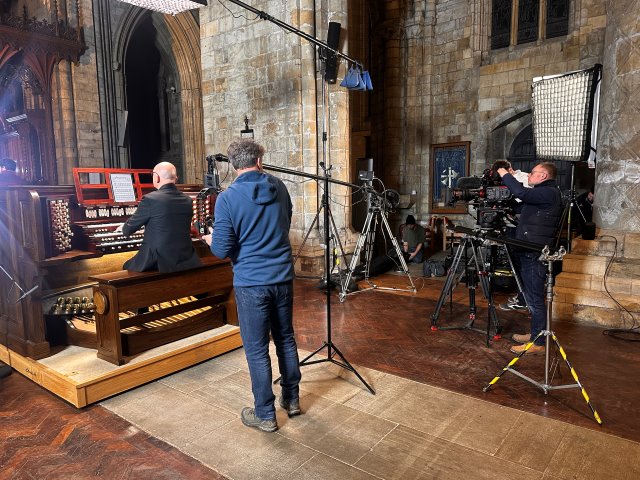Joseph Nolan plays a Regent Classic custom organ at Selby Abbey.
Early in 2025, Regent Classic took its latest hire organ to Selby Abbey for a recording session with celebrated British-Australian organist, Joseph Nolan. The new custom hire organ was destined for St. John’s College, Cambridge, and will serve as a temporary instrument in the chapel while the current Mander organ is replaced by a rebuilt Willis from St Peter’s Church, Brighton. It has a stop list identical to that of the Willis rebuild, and some 21st century features that Father Willis himself might have found intriguing, such as a Bluetooth iPad page-turning piston that you will see used on some of these recordings, and a phone charging port.
For the Selby recording the instrument was temporarily installed in the Abbey with the speaker system that Regent Classic had previously put in the nave triforium. Over the course of a January evening after the doors had closed to the public, Joseph recorded the Messerer arrangement of Bach’s D minor Chaconne and Boëllmann’s Suite Gothique.
Bach’s Chaconne in D minor
Bach’s Chaconne in D minor was originally a solo violin piece, the last movement of a larger Partita, BWV 1004, written sometime between 1717 and 1720. It has experienced some remarkable transcriptions for other instruments, such as the harpsichord, cello and guitar, and at least two composers have written piano accompaniments for it. There’s also an orchestral version by Leopold Stokowski. Notable among the keyboard transcriptions, or perhaps we should call them arrangements, are the Busoni version for the piano, and the one we hear here, arranged by French organist and composer, Henri Messerer. The Messerer arrangement is not the only organ rendering, by any means, there also being versions by W.T. Best and others.

Busoni’s piano arrangement is a massive piece that captures the high drama of the D minor Chaconne, employing all sorts of virtuosic piano devices that take us from the grandest fortissimi to the quietest pianissimi. It takes the sparse implied harmony of the violin Partita, which relies on a lot of double and triple stopping, and expands it to take advantage of the full forces of a grand piano. One might even believe it had originally been written for the piano. So it is with Messerer’s arrangement for the organ. We get a grand romantic arrangement of a baroque piece that takes advantage of everything a large organ has to offer. It provides an excellent opportunity for Joseph to take advantage of all the different colours that this Regent Classic organ has to hand.
Arrangement by Henri Messerer
The arranger, Henri Messerer, was born in Marseille in 1838, where he spent much of his career, eventually becoming director of the local music conservatoire. He was in charge of a substantial Cavaillé-Coll instrument in the city, and we can only assume that he had many of the sounds of this in mind when he arranged Bach’s Chaconne.

A Chaconne, rather like a Passacaglia, is a musical dance form based on a repeating harmonic pattern and sometimes a repeating bass phrase, although the latter is more typically evident in the Passacaglia. What we get in this case is a set of variations on a repeating harmonic theme, which brings out all the brilliance of Bach’s inventiveness.
As with many compositional techniques, the discipline of the repeating pattern provides a framework for the most beautiful art. Notice how the pattern is woven into the fabric of this remarkable work, passing through a number of surprisingly different iterations, rising to a stunning conclusion that demands the full forces of this high quality instrument, and demonstrating the brilliant virtuosity of Nolan’s technique.
I’m a retired academic, with a background in music and audio engineering. I’m currently a consultant for Viscount & Regent Classic Organs, as well as being a freelance organist, including a role as organist/choirmaster at St Mary’s, Witney. I sing bass with Oxford Pro Musica Singers and the Cathedral Singers of Christ Church, Oxford.


